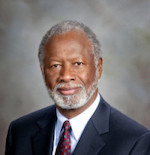It’s unclear whether, going into Tuesday, Frank LaRose anticipated that the measure he was championing was going to fail — even though related issues have gotten trounced in state after state after state.
But by Election Day, early voting had been torrid for weeks — especially in big cities where people were likely to vote against Issue 1, the initiative LaRose was supporting. Prospects seemed to be dimming for the measure — which would have made it much more difficult for voters to initiate and pass amendments to the state Constitution.
By Tuesday morning, LaRose, who was the most visible face of Issue 1, might have been worried. Before noon, he ducked a meeting with reporters. That afternoon, he was attacked by an Arizona Republican who came to Ohio to campaign for Issue 1. That evening, after the blowout became apparent, he skipped a press conference and the official speaking in his place pointed blame at his fellow Republicans.
At 11:23 p.m., LaRose broke his silence by issuing a statement. It was angry, misleading, and hardly a concession that voters disliked his proposal, which they defeated by a 14-point margin. Making the loss even more bitter, some counties that had voted for Donald Trump in 2020 joined the chorus in voting “no” on Issue 1.
Long effort, snap vote
LaRose had been on a path to Tuesday’s defeat at least since November 2022, when he and Rep. Brian Stewart, R-Ashville, proposed raising the threshold to pass citizen-initiated amendments from 50% of the vote to 60% of the vote.
Even then, the two struggled to articulate why it was necessary to gut a 1912 measure championed by Theodore Roosevelt to fight corruption and tame an unresponsive government. At their introductory press conference, LaRose and Stewart said they didn’t want nefarious outside interests meddling in the Ohio Constitution, but they didn’t name a single instance in which that happened in the current system’s 110-year existence.
The November 2022 press conference was just weeks after an election in which Ohio candidates for the Statehouse and Congress ran in districts the state Supreme Court had repeatedly ruled were unconstitutionally gerrymandered. The districts were still in place because the Republican-dominated Redistricting Commission — on which LaRose sits — refused to submit maps that were acceptable to a bipartisan majority of the court.
The press conference also took place about five months after harsh abortion restrictions took effect when the U.S. Supreme Court overturned Roe v Wade. Horror stories quickly followed of a 10-year-old rape victim, pregnant cancer patients in need of treatment, and women whose pregnancies couldn’t succeed. They might have needed abortions, but they couldn’t get them in Ohio.
Amendments protecting abortion rights and curbing gerrymandering appeared to be on the horizon, but LaRose denied at that initial press conference that he wanted to make it harder for voters to change the Constitution in order to block them.
“If you’re going to amend the Constitution, you need to be thinking about the long term,” he said. “So anybody who’s thinking about shorter or transient goals in the next year or two or three years, that’s not what this kind of a change should ever be about.”
Even though LaRose claimed he was thinking long-term, he and Stewart tried to jam the measure through a lame-duck session of the legislature.
It’s not clear if it was the reason for failure, but Stewart contradicted LaRose’s claims on Dec. 14, when he sent a letter to Republican lawmakers saying that the real reason to restrict voter access to the Constitution was to block abortion-rights and anti-gerrymandering amendments.
Second try
LaRose was reportedly angry with Stewart for saying the quiet part out loud, but that didn’t stop the two earlier this year from again proposing to make it harder for voters to amend the Ohio Constitution. And this version, when it made it out of the legislature, contained a new provision that would have made it extremely difficult for voter groups to get a proposed amendment on the ballot in the first place.
The groups already had to gather hundreds of thousands of verified voter signatures and a portion of them had to come from 44 counties. The new proposal required that a portion had to come from each of the state’s 88 counties — including those like Vinton, whose 12,800 residents are thinly spread across its 412 square miles.
Meanwhile, the proposal coming out of the gerrymandered legislature placed no additional burdens on that body’s ability to put constitutional amendments on the ballot. In other words, it would enhance the corruption-plagued General Assembly’s power relative to the voters, and voter power is already stunted through gerrymandering.
The Republican majority in the legislature gave still more evidence that the proposed restrictions were aimed at thwarting a proposed abortion-rights amendment headed for the November ballot. It set the election for the new constitutional restrictions for a traditionally low-turnout Aug. 8 election.
And it did so mere months after it had passed a law outlawing such elections. But the new, more hard-right majority on the Ohio Supreme Court ruled that the legislature didn’t have to obey its own laws — at least in this case.
Misleading claims, contradictions
During the campaign for the new measure, it was LaRose’s turn to say the quiet part out loud. In May, after months of claiming the opposite, the state’s top elections officer told a group of Seneca County Republicans his proposal was “100% about keeping a radical pro-abortion amendment out of our Constitution,” WEWS in Cleveland reported.
It was far from the only misleading or contradictory claim made by LaRose and his allies:
- Between 2018 and 2020, the gerrymandered legislature was the scene of the biggest corruption scandal in state history. But LaRose argued that enhancing that body’s power over the Constitution would somehow stop corruption — including a part of the massive bribery scandal that is still rocking Capitol Square. The secretary of state, however, refuses to discuss his own role in that scandal, which came up several times in federal court earlier this year.
- LaRose claimed it was vital to pass Issue 1 to block amendments that would take away “individual” gun rights. But that ignores that the U.S. Supreme Court enshrined those rights in Heller v District of Columbia and in subsequent decisions.
- LaRose and his allies relentlessly claimed that the abortion-rights amendment that will be on the November ballot would allow minors to undergo sex changes without their parents’ permission. But legal experts told the Cincinnati Enquirer that’s “highly unlikely” for many reasons. The Ohio Children’s Hospital Association has said in testimony at the Statehouse that under their standards, this does not happen in Ohio.
- The “yes” on Issue 1 campaign has also relentlessly harped on the out-of-state funding flowing to the “no” campaign. But that ignores the millions the “yes” campaign has gotten from a billionaire election denier in Illinois and from other contributors in Georgia, Kentucky, Tennessee and New York.
- Even the motto of the “yes” campaign was misleading. It was called Protect Our Constitution while proposing a radical change to it. The “no” campaign was the one trying to preserve the pact as it is.
In the end, all the fibs and inconsistencies appear to have cost LaRose and his allies.
“In addition to their views on abortion, many who cast ballots in Ohio’s referendum on Tuesday said they felt the measure’s backers weren’t being honest about its purpose,” said the sub-headline of a New York Times story in which more than three dozen voters were interviewed.
It was a classic case of politicians not giving voters enough credit, said University of Houston political scientist Brandon J. Rottinghaus.
“There’s a tendency by political professionals to think that voters can be inherently and consistently manipulated,” he said on Thursday. “That is not always the case. In moments where voters perceive that their rights are being taken away, they will act, and I think that’s largely what we saw here.”
Bitter defeat
Perhaps as that realization dawned on LaRose on Election Day, he hastily canceled an 11 a.m. event in which he was supposed to vote at his Upper Arlington polling place and then speak to reporters. His spokesman blamed it on a protest, but that consisted of seven people peacefully holding “no” signs nearby.
Then, that afternoon, LaRose took incoming fire from an erstwhile ally in the “yes” campaign. Kari Lake, who lies about her loss in last year’s Arizona governor’s race and about Donald Trump’s in 2020, took to X (formerly Twitter) to trash LaRose over his conduct of the election.
“Perhaps if the Secretary of State spent less time auditioning for a new job, he wouldn’t be screwing up his current one,” she said.
Lake later endorsed one of LaRose’s opponents in the Republican Primary for U.S. Senate — Cleveland businessman Bernie Moreno.
After polls closed at 7:30 p.m., early results started coming in. Those tend to favor Democrats and they favored the “no” side. But early on, the leads approached 80%.
As expected, that lead trended down through the evening as Election Day results flowed in. But it was nowhere near to the extent the “yes” side needed if it was to have a prayer of winning.
Shortly before 9 p.m., the Associated Press said the race was over. The “no” side had won. Resoundingly.
But in the room where the Ohio Republican Party sequestered reporters, all they could do was wait.
Then, almost an hour later, somebody came out to talk to the press. It wasn’t LaRose, but Senate President Matt Huffman, R-Lima.
He said there wasn’t enough time to organize the “yes” campaign, even though he played a central role in putting the matter on the August ballot. Huffman also blamed other Republicans for the defeat.
“This was a heavy lift and we needed ‘all hands-on deck,’ which disappointingly we didn’t have,” Huffman said in a statement.
Huffman’s spokesman didn’t respond when asked whether the Senate president faulted LaRose for trying to rush through Issue 1 or for other shortcomings of the campaign. Huffman did, however, double down on his commitment to keep Ohio’s abortion restrictions in place and to make it much harder for voters to amend the state Constitution.
Sore loser?
It’s a democratic norm that when politicians lose an election, they concede defeat and acknowledge the will of the voters. But for about 90 minutes after Huffman spoke and two-and-half hours after AP called the race, from the LaRose camp there were… crickets.
Spokesmen for LaRose and Huffman didn’t respond when asked why LaRose didn’t appear before the press.
But at 11:23 p.m. he put out a statement that was hardly conciliatory — even though his proposal had just gone down to a 57-43 defeat. It also repeated many of the misleading claims that might have doomed it in the first place.
“Unfortunately, we were dramatically outspent by dark money billionaires from California to New York, and the giant ‘for sale’ sign still hangs on Ohio’s Constitution,” it said. “Ohioans will see the devastating impact of this vote soon enough. The radical activists that opposed Issue 1 are already planning amendments to shut parents out of a child’s life-altering medical procedure, force job killing wage mandates on small businesses, prevent law abiding citizens from protecting their families and remove critical protections for our first responders.”
Despite voters’ clear rejection Tuesday, LaRose vowed to keep trying.
“I’ve said for months now that there’s an assault coming on our Constitution, and that hasn’t changed,” he said. “I’m just getting started in the fight to protect Ohio’s values.”
• • •• • •
This story is provided by Ohio Capital Journal, a part of States Newsroom, a national 501 (c)(3) nonprofit. See the original story here.



















